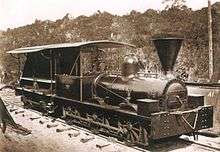History of rail transport in Brazil
- This article is part of the history of rail transport by country series

The history of rail transport in Brazil dates back to 1854. In that year, Brazil's first railway line, with a gauge of 1,676 mm (5 ft 6 in), was completed between the port of Mauá, in Guanabara Bay in the then province of Rio de Janeiro, and Fragoso in the Brazilian hinterland. The steam locomotive Baroneza hauled the trains on this 14 km (8.7 mi) long line.
Soon afterwards, the line was extended to Raiz da Serra. Thirty years later, the railway company Estrada de Ferro Leopoldina further extended the line up into the mountains as far as Petrópolis. During this period, many railway lines were constructed and put into operation in Brazil by regional train operating companies.
The establishment of a superior, state railway company took place in 1957. On 16 March of that year, Rede Ferroviária Federal, Sociedade Anônima (RFFSA) was founded in a merger of 18 (later 19) individual regional companies. The RFFSA route network was used for both passenger and freight trains. Between 1996 and 1998, RFFSA was privatized, and in 2007 it was finally dissolved. During the privatisation and dissolution process, the RFFSA's route network was regionalised and licensed for operation by private companies.
See also
References
- Hollingsworth, J B (1980). Atlas of the World's Railways. Adelaide: Rigby. pp. 194–197. ISBN 0727003054.
External links
![]() Media related to History of rail transport in Brazil at Wikimedia Commons
Media related to History of rail transport in Brazil at Wikimedia Commons